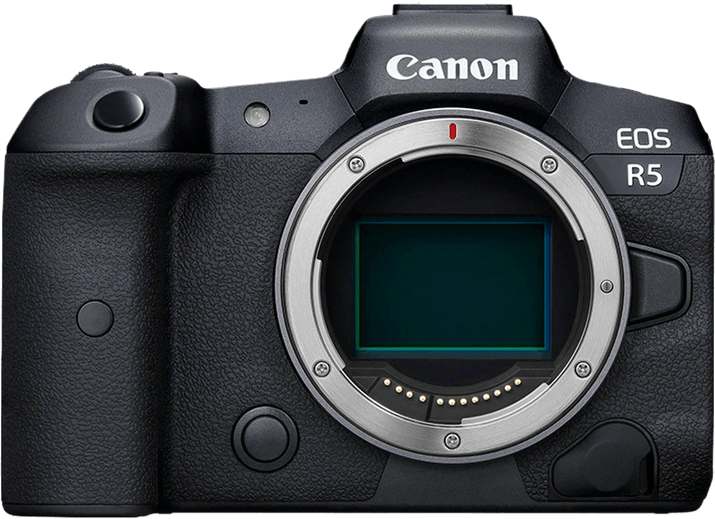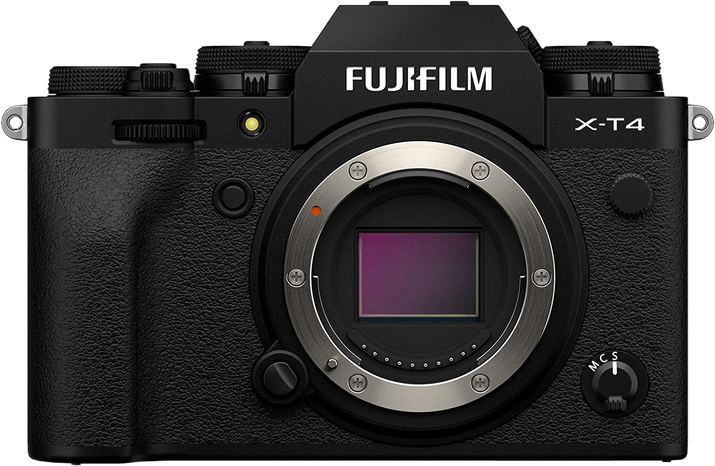Canon EOS R5 vs Fujifilm X-T4 Comparison
Canon EOS R5

Fujifilm X-T4

The Canon EOS R5 takes the lead with a score of 86/100, while the Fujifilm X-T4 trails with a score of 76/100. Both cameras share similarities, such as being mirrorless and having a 2020 release year. They also have similar dimensions, with the Canon EOS R5 measuring 138 x 98 x 88mm and the Fujifilm X-T4 at 135 x 93 x 84mm.
The Canon EOS R5 outperforms the Fujifilm X-T4 with its higher score, which reflects its better features and performance. However, the Fujifilm X-T4 has an advantage in weight, being lighter at 607g compared to the Canon EOS R5’s 680g. This difference may be significant for some users who prioritize portability.
On the other hand, the Canon EOS R5 comes with a heftier launch price of $4499, while the Fujifilm X-T4 is more affordable at $1699. Ultimately, the choice between these two cameras depends on the user’s preferences and budget. The Canon EOS R5 offers superior performance, while the Fujifilm X-T4 provides a more budget-friendly and lighter option.
Canon EOS R5 vs Fujifilm X-T4 Overview and Optics
The Canon EOS R5 outperforms the Fujifilm X-T4 in optics, scoring 88/100 compared to the X-T4’s 73/100. Both cameras share some common specifications, such as a CMOS sensor, 20 fps shooting speed, and image stabilisation. However, there are significant differences that contribute to the R5’s higher score.
The R5 boasts a higher megapixel count at 45, compared to the X-T4’s 26, which results in more detailed and higher resolution images. The R5 also has a more advanced processor, the Digic X, which ensures faster image processing and better overall performance. Additionally, the R5’s full-frame sensor size provides better low light performance, increased dynamic range, and improved image quality over the X-T4’s APS-C sensor. The Canon RF lens mount offers a wider range of lenses, ensuring more versatility for photographers.
On the other hand, the Fujifilm X-T4 has some advantages despite its lower score. Its X-Processor 4 is a reliable and efficient processor, even if it is not as advanced as the R5’s Digic X. The Fujifilm X lens mount also offers a good selection of lenses, though not as extensive as Canon’s RF mount.
The Canon EOS R5’s superior optics make it the clear winner in this comparison. Its higher megapixel count, more advanced processor, full-frame sensor, and broader lens selection contribute to its higher score and better overall performance. While the Fujifilm X-T4 is still a reliable option, it falls short in terms of optics when compared to the R5.
Canon EOS R5 vs Fujifilm X-T4 Video Performance
The Canon EOS R5 outperforms the Fujifilm X-T4 in video capabilities with a score of 100/100, compared to the X-T4’s 91/100. Both cameras share some common specifications, such as a maximum video frame rate of 120fps and built-in time-lapse functionality. However, the EOS R5 surpasses the X-T4 in certain aspects, making it the superior choice for video recording.
One of the main advantages of the Canon EOS R5 is its maximum video resolution of 8K (8192 x 4320), which is double the resolution of the Fujifilm X-T4’s 4K (4096 x 2160). This results in significantly clearer and more detailed video footage, making the EOS R5 ideal for professional videographers and filmmakers who require the highest quality output.
While the Fujifilm X-T4 does not match the EOS R5 in terms of video resolution, it still offers excellent video performance with its 4K resolution. The X-T4’s video score of 91/100 is still impressive, and the camera is a suitable option for those who do not require 8K video capabilities.
When comparing the video capabilities of the Canon EOS R5 and the Fujifilm X-T4, it is clear that the EOS R5 is the superior choice due to its higher video score, 8K resolution, and overall better performance. The Fujifilm X-T4, however, remains a strong option for those who do not require the utmost video quality and prefer a more affordable camera with solid 4K video capabilities.
Canon EOS R5 vs Fujifilm X-T4 Features and Benefits
The Canon EOS R5 is the winner in terms of features, scoring 87 out of 100 points, while the Fujifilm X-T4 lags slightly behind with 85 points. Both cameras share several common specifications, including touchscreen capability, flip screens, absence of GPS, and the presence of WIFI and bluetooth connectivity.
The Canon EOS R5 outperforms the Fujifilm X-T4 in screen size and resolution. The R5 has a 3.2-inch screen, which is larger than the X-T4’s 3-inch screen. Additionally, the R5 boasts a screen resolution of 2,100,000 dots, giving users a clearer and more detailed view of their photos compared to the X-T4’s resolution of 1,620,000 dots. These features make the R5 a more user-friendly and visually impressive option.
On the other hand, the Fujifilm X-T4 has its own strengths. Despite having a lower feature score, the X-T4 still offers a high-quality touchscreen, flip screen, and wireless connectivity options as the R5. This means that the X-T4 can still satisfy the needs of many photographers who do not prioritize screen size and resolution as much.
Ultimately, the Canon EOS R5 takes the lead in the features category due to its larger screen and higher resolution, providing users with a more enjoyable and precise photography experience. However, the Fujifilm X-T4 remains a strong contender, as it offers similar features and can cater to photographers who may not require the extra screen size and resolution offered by the R5.
Canon EOS R5 vs Fujifilm X-T4 Storage and Battery
The Fujifilm X-T4 outperforms the Canon EOS R5 in storage and battery with a score of 73/100 compared to the R5’s 68/100. Both cameras share similarities in storage, featuring two memory card slots and compatibility with SD, SDHC, and SDXC (UHS-II) cards. However, the R5 also accepts CFexpress cards, providing an advantage in storage options.
The X-T4’s superiority lies in its battery life, offering 500 shots compared to the R5’s 320 shots. Both cameras use different battery types, with the X-T4 using NP-W235 and the R5 using LP-E6NH. Additionally, both cameras support USB charging, adding convenience for users.
While the R5 has the advantage of accepting CFexpress cards, the X-T4’s longer battery life makes it a better choice for those prioritizing extended shooting sessions. Despite the difference in scores, both cameras offer reliable storage and battery options to suit various needs.
Canon EOS R5 vs Fujifilm X-T4 – Our Verdict
Are you still undecided about which camera is right for you? Have a look at these popular comparisons that feature the Canon EOS R5 or the Fujifilm X-T4:

